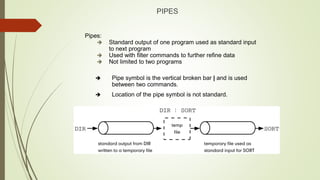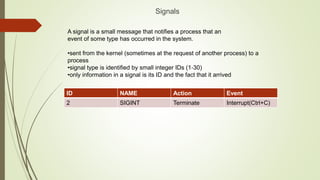Unix_Introduction_BCA.pptx the very basi
- 2. What is Unix? Just like Windows, it is an operating system. Linux is one of the popular versions of the UNIX operating system, which is designed to offer a free or low cost operating system for personal computer users. Android is powered by the Linux operating system. An operating system is software that manages all of the hardware resources associated with your desktop or laptop. To put it simply, the operating system manages the communication between your software and your hardware. Without the operating system (OS), the software wouldn't function.
- 3. Why use? Does that operating system you are currently using really work ? Or, do you find yourself battling obstacles like viruses, malware, slow downs, crashes, costly repairs, and licensing fees? If you struggle with the above, Unix or its flavour might be the perfect platform for you. Combine that reliability with zero cost (Free)of entry and you have the perfect solution for a desktop platform. Open source Open source follows these key tenants: The freedom to run the program, for any purpose. The freedom to study how the program works, and change it to make it do what you wish. The freedom to redistribute copies so you can help your neighbour. The freedom to distribute copies of your modified versions to others.
- 4. The Linux operating system comprises several different pieces: Bootloader – The software that manages the boot process of your computer. For most users, this will simply be a splash screen that pops up and eventually goes away to boot into the operating system. Kernel – This is the one piece of the whole that is actually called Unix. The kernel is the core of the system and manages the CPU, memory, and peripheral devices. The kernel is the lowest level of the OS. Daemons – These are background services (printing, sound, scheduling, etc.) that either start up during boot or after you log into the desktop. etc.
- 5. Unix System Architecture The kernel is the core part of the operating system, which is responsible for all the major activities of the operating system
- 6. Portable: Unix operating system can work on different types of hardware's as well as kernel supports the installation of any kind of hardware platform. Open Source: Source code of operating system is freely available and, to enhance the ability of the operating system, many teams work in collaboration. Multiuser: It is a multiuser system, which means, multiple users can access the system resources like RAM, Memory or Application programs at the same time. Multiprogramming: It is a multiprogramming system, which means multiple applications can run at the same time. Shell: Unix operating system offers a special interpreter program, that can be used to execute commands of the OS. It can be used to do several types of operations like call application programs, and so on. Security: Unix operating system offers user security system using authentication features like controlled access to particular files. Features of Unix Operating System
- 7. Applications User Support Tools Text processing (vi, sed, awk) Productivity applications Programmer Support Tools Programming languages & compilers (C, C++, Java) Shell scripts Personal software process: version control Source Code Control System (SCCS) Revision Control System (RCS) Unix as server Web server, mail server, application server
- 8. Some Unix distributions include: Solaris AIX IBM HP-UX NetBSD Xenix macOS
- 9. UNIX Shells sh Bourne shell: Steve Bourne, 1978 Almquist shell (ash): BSD sh replacement Bourne-Again shell (bash): GNU/Linux csh C shell, Bill Joy, BSD, 1978 tcsh Tenex C shell (tcsh): GNU/Linux others: Korn shell (ksh), Zshell (zsh), …
- 10. Help Some web sites www.unixtools.com www.ugu.com www.unix-manuals.com www.unixcities.com www.tldp.org www.linux.com www.linux.org linux.die.net
- 11. The most common Unix/Linux commands Command Description cat [filename] Display file’s contents to the standard output device (usually your monitor). cd /directorypath Change to directory. chmod [options] mode filename Change a file’s permissions. chown [options] filename Change who owns a file. clear Clear a command line screen/window for a fresh start. cp [options] source destination Copy files and directories. date [options] Display or set the system date and tim
- 12. df [options] Display used and available disk space. du [options] Show how much space each file takes up. file [options] filename Determine what type of data is within a file. find [pathname] [expression] Search for files matching a provided pattern. kill [options] pid Stop a process. If the process refuses to stop, use kill -9 pid. less [options] [filename] View the contents of a file one page at a time. ln [options] source [destination] Create a shortcut. locate filename Search a copy of your filesystem for the specified filename. lpr [options] Send a print job. ls [options] List directory contents.
- 13. man [command] Display the help information for the specified command. mkdir [options] directory Create a new directory. mv [options] source destination Rename or move file(s) or directories. passwd [name [password]] Change the password or allow (for the system administrator) to change any password. ps [options] Display a snapshot of the currently running processes. pwd Display the pathname for the current directory. rm [options] directory Remove (delete) file(s) and/or directories. rmdir [options] directory Delete empty directories. ssh [options] user@machine Remotely log in to another Linux machine, over the network. Leave an ssh session by typing exit.
- 14. su [options] [user [arguments]] Switch to another user account. tail [options] [filename] Display the last n lines of a file (the default is 10). tar [options] filename Store and extract files from a tarfile (.tar) or tarball (.tar.gz or .tgz). top Displays the resources being used on your system. Press q to exit. touch filename Create an empty file with the specified name. who [options] Display who is logged on.
- 15. Unix directory structure revisited 'cd ~' change directory to your home 'cd ~ sonali' change directory to sonali's home 'cd ..' change directory to upper directory 'cd / ' change directory to root Use tabs to complete the file name (write partial file name and then use tab) File Commands
- 16. Permissions – important for sharing your files and restricting access on your work 'chmod 755' => rwx rwx rwx (user group all) 'chmod a+r' => (u/g/a) ( +/ -) (r/w/x) ‘file’ utility tells type of file like text, word or pdf (Helpful when extension is not given) Important filters- 'grep word path/filename', grep find a word in a file pipes ' | ' : redirect output of one command to other command 'more' or 'less' shows files pagewise ‘find’ and ‘locate’ utility help to find a file by filename ‘find –r path –name filename’ will find the location of file in given path. Useful command as we can use wild card pattern File Commands
- 17. fast and easy Basic modes- edit and command, ‘esc’ for command mode ‘i, a’ for edit mode (insert or append mode) Other commands using colon- :q,:w,:q!,:e :q for quit, :w for write, :q! quit without save :e open another file for editing, :wq write and quit Searching using ‘/’ In command mode use ‘/’ then write the word you want to search ‘n’ for forward search, ‘N’ for backward search Search and replace :s/ram/mohan - will search string “ram” and replace with “mohan” Advanced vi – vim(vi improve) and gvim(gnu vim) VI EDITOR
- 21. Discussed in Class in Detail(with example and diagram): User File descriptor table( per process) File table(global kernel structure) Inode table Inode in detail: Process access to data blocks. Addressing scheme and Calculation.
- 23. Discussed in Class in Detail (with algorithm) File Input output. Lseek Other file system calls Stat() Fstat()
- 27. Process: Def Process Control System States : 1-9 Data structures ( with contents of each): •Process table •U area Context of a process (user context, register, system level) Context switching and steps
- 28. „ System calls: ƒ fork() spawns new process Called once, returns twice ƒ exit() terminates own process ƒ Called once, never returns ƒ Puts it into “zombie” status ƒ wait() for terminated children ƒ execl() run new program in existing process ƒ
- 30. Redirection Will use redirection to redirect standard input and standard output. Operating system gets information from or sends information to: Standard input Standard output Standard error
- 31. Redirection I/O redirection tells OS you want information read from or written to a device other than the standard ones. Symbols used for redirection: > (greater than) < (less than) >> (double greater than)
- 32. Redirection Redirection works with commands that write their results to standard output device (screen) Using > COPY can only copy files, not commands Using < Any input from keyboard ignored if redirection of input is from a file Using > between files - first file overwrites second file Using >> between files - first file appended to end of second file
- 33. Filters Three filter commands: SORT FIND MORE Operating system creates temporary files while it “filters” data. Operating system will not be able to execute filter commands on write- protected disk.
- 34. Filters SORT filter command: Arranges lines of input in ascending order Sends output to standard output unless redirected SORT syntax: SORT [/R] [/+N] [/M kilobytes] [/L locale] [/REC recordbytes] [[drive:] [path1] filename1] [/T [drive2:] [path2]] [O [drive3:] [path3] filename3]
- 35. Filters FIND filter command: Allows you to search a file for a specific character string by enclosing it in quotation marks. FIND syntax: FIND [/V] [/C] [/N] [/I] [/OFF[LINE]]“string” [[drive:] [path] filename[ …]] FIND command is looking for exact match, therefore, is case sensitive unless /I parameter is used. FIND parameters: /I - ignores case /V - search a file for anything except what is in quotes /N - finds specific line number of each occurrence /C - numeric count of number of times specific character string appears in a file
- 36. PIPES Pipes: Standard output of one program used as standard input to next program Used with filter commands to further refine data Not limited to two programs Pipe symbol is the vertical broken bar | and is used between two commands. Location of the pipe symbol is not standard.
- 37. Signals A signal is a small message that notifies a process that an event of some type has occurred in the system. •sent from the kernel (sometimes at the request of another process) to a process •signal type is identified by small integer IDs (1‐30) •only information in a signal is its ID and the fact that it arrived ID NAME Action Event 2 SIGINT Terminate Interrupt(Ctrl+C)
- 38. Sending Signals Kernel sends (delivers) a signal to a destination process by updating some state in the context of the destination process Kernel sends a signal for one of the following reasons: •ƒ Kernel has detected a system event such as divide‐by‐zero (SIGFPE) or •the termination of a child process (SIGCHLD) •ƒ Another process has invoked the kill system call to explicitly request •the kernel to send a signal to the destination process
- 39. A destination process receives a signal when it is forced by the kernel to react in some way to the delivery of the signal „Three possible ways to react: •ƒ Ignore the signal (do nothing) •ƒ Terminate the process (with optional core dump) •ƒ Catch the signal by executing a user‐level function called signal handler ƒ Akin to a hardware exception handler being called in response to an asynchronous interrupt Receiving Signals





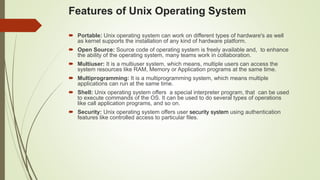




![The most common Unix/Linux commands
Command Description
cat [filename]
Display file’s contents to the standard output
device
(usually your monitor).
cd /directorypath Change to directory.
chmod [options] mode filename Change a file’s permissions.
chown [options] filename Change who owns a file.
clear
Clear a command line screen/window for a
fresh start.
cp [options] source destination Copy files and directories.
date [options] Display or set the system date and tim](https://image.slidesharecdn.com/unixintroductionbca-240226154250-71f060b3/85/Unix_Introduction_BCA-pptx-the-very-basi-11-320.jpg)
![df [options] Display used and available disk space.
du [options] Show how much space each file takes up.
file [options] filename Determine what type of data is within a file.
find [pathname] [expression] Search for files matching a provided pattern.
kill [options] pid
Stop a process. If the process refuses to stop,
use kill -9 pid.
less [options] [filename] View the contents of a file one page at a time.
ln [options] source [destination] Create a shortcut.
locate filename
Search a copy of your filesystem for the
specified
filename.
lpr [options] Send a print job.
ls [options] List directory contents.](https://image.slidesharecdn.com/unixintroductionbca-240226154250-71f060b3/85/Unix_Introduction_BCA-pptx-the-very-basi-12-320.jpg)
![man [command]
Display the help information for the specified
command.
mkdir [options] directory Create a new directory.
mv [options] source destination Rename or move file(s) or directories.
passwd [name [password]]
Change the password or allow (for the system
administrator) to
change any password.
ps [options]
Display a snapshot of the currently running
processes.
pwd
Display the pathname for the current
directory.
rm [options] directory Remove (delete) file(s) and/or directories.
rmdir [options] directory Delete empty directories.
ssh [options] user@machine
Remotely log in to another Linux machine,
over the network.
Leave an ssh session by typing exit.](https://image.slidesharecdn.com/unixintroductionbca-240226154250-71f060b3/85/Unix_Introduction_BCA-pptx-the-very-basi-13-320.jpg)
![su [options] [user [arguments]] Switch to another user account.
tail [options] [filename]
Display the last n lines of a file (the
default is
10).
tar [options] filename
Store and extract files from a tarfile (.tar)
or tarball (.tar.gz or .tgz).
top
Displays the resources being used on
your system. Press q to
exit.
touch filename
Create an empty file with the specified
name.
who [options] Display who is logged on.](https://image.slidesharecdn.com/unixintroductionbca-240226154250-71f060b3/85/Unix_Introduction_BCA-pptx-the-very-basi-14-320.jpg)


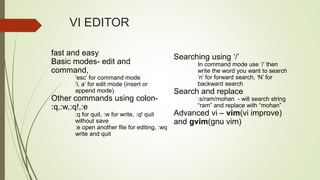







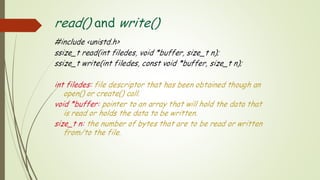







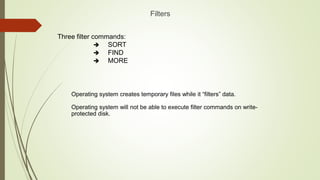
![Filters
SORT filter command:
Arranges lines of input in ascending order
Sends output to standard output unless redirected
SORT syntax:
SORT [/R] [/+N] [/M kilobytes] [/L locale] [/REC recordbytes]
[[drive:] [path1] filename1] [/T [drive2:] [path2]] [O [drive3:]
[path3] filename3]](https://image.slidesharecdn.com/unixintroductionbca-240226154250-71f060b3/85/Unix_Introduction_BCA-pptx-the-very-basi-34-320.jpg)
![Filters
FIND filter command:
Allows you to search a file for a specific character string by
enclosing it in quotation marks.
FIND syntax:
FIND [/V] [/C] [/N] [/I] [/OFF[LINE]]“string”
[[drive:] [path] filename[ …]]
FIND command is looking for exact match, therefore, is case sensitive
unless /I parameter
is used.
FIND parameters:
/I - ignores case
/V - search a file for anything except what is in quotes
/N - finds specific line number of each occurrence
/C - numeric count of number of times specific character string
appears in a file](https://image.slidesharecdn.com/unixintroductionbca-240226154250-71f060b3/85/Unix_Introduction_BCA-pptx-the-very-basi-35-320.jpg)
